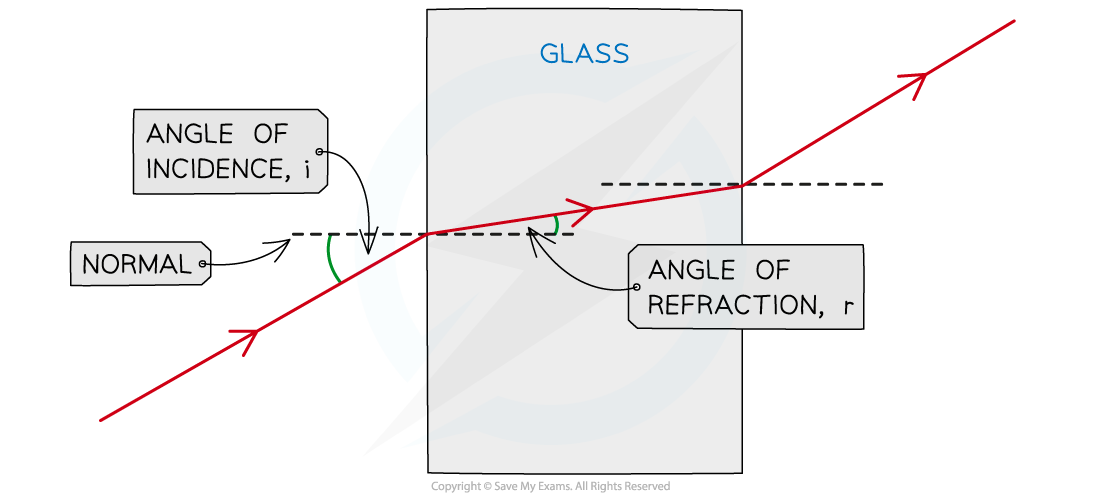Reflection & Refraction of Waves (WJEC GCSE Physics) : Revision Note
Reflection & Refraction of Waves
All waves, whether transverse or longitudinal, can be reflected and refracted
Reflection
Reflection occurs when:
A wave hits a boundary between two media and does not pass through, but instead stays in the original medium
Angles are measured between the wave direction (ray) and the normal
The normal is perpendicular to the surface of the boundaries and is usually represented by a straight line or dotted line
The angle of the wave approaching the boundary is called the angle of incidence (i)
The angle of the wave leaving the boundary is called the angle of reflection (r)
The angles are the same, so the law of reflection can be written:
Angle of incidence (i) = Angle of reflection (r)
Light Reflecting From a Surface

The angle of incidence and angle of reflection are the same when light reflects from a surface
Examiner Tips and Tricks
When drawing ray diagrams for reflection take care to draw the angle correctly. If it is slightly out it won’t be a problem, but if there is an obvious difference between the angle of incidence and the angle of reflection then you will probably lose a mark!
Refraction
Refraction is:
The change in direction of a wave which is caused by a change in the speed of the wave
Refraction can occur when a wave crosses a boundary between two materials with different densities or when water passes over a boundary of different depths of water
In some cases, the wave will change direction
Refraction of water waves
Refraction can occur when water waves travel from deep water to shallow water
This effect can be observed using water waves in a ripple tank
Refraction can be represented using wavefront diagrams, as shown below:
Water Waves Refracting in a Ripple Tank

The different parts of the wave enter a different depth of water at different times causing the wave to bend
When water waves pass from deep water to shallow water:
The wave speed decreases
The wavelength decreases
The frequency remains the same
The difference in speed between the parts of the wave in deep water and the parts in the shallow water causes the wave to bend
Hence, this leads to a change in direction
If the boundary between the deep water and shallow water is perpendicular to the wavefront, the whole wavefront will change speed at the same time and the wave will not change direction
Refraction of light
Refraction also occurs when light passes a boundary between two different transparent media
At the boundary, the rays of light undergo a change in direction
The direction is taken as the angle from the normal
The change in direction depends on the difference in density between the two media:
From less dense to more dense (e.g air to glass), light bends towards the normal
From more dense to less dense (e.g. glass to air), light bends away from the normal
When passing along the normal (perpendicular) the light does not bend at all
Refraction of Light Through a Glass Prism

Light enters the glass prism where the light ray bends towards the normal. Light bends away from the normal as it exits the glass prism
The change in direction occurs due to the change in speed when travelling in different substances
When light passes into a denser substance the rays will slow down, hence they bend towards the normal
As with refraction of water waves, the only properties that change during refraction of light are speed and wavelength – the frequency of waves does not change
Different frequencies account for different colours of light (red has a low frequency, whilst blue has a high frequency)
When light refracts, it does not change colour (think of a pencil in a glass of water), therefore, the frequency does not change
Worked Example
Two parallel rays of light entering and passing through prism A and prism C.

Draw a third parallel ray entering and passing through prism B.
Answer:
Step 1: Draw a parallel ray on the left

Step 2: Draw the refracted ray at the first surface

As the ray enters the block it bends towards the normal since it is going into a denser material
In this case, the angle of refraction is smaller than the angle of incidence
Step 3: Draw the refracted ray at the second surface

As the ray leaves the block it bends away from the normal
In this case, the angle of refraction is larger than the angle of incidence
Examiner Tips and Tricks
Practice drawing refraction diagrams as much as you can! It's very important to remember which way the light bends when it crosses a boundary:
As the light enters the block it bends towards the normal line
Remember: Enters Towards
When it leaves the block it bends away from the normal line
Remember: Leaves Away
Don't forget to draw the arrows for the direction of the light rays and make sure they are drawn with a ruler and a sharp pointed pencil

You've read 0 of your 5 free revision notes this week
Sign up now. It’s free!
Did this page help you?
